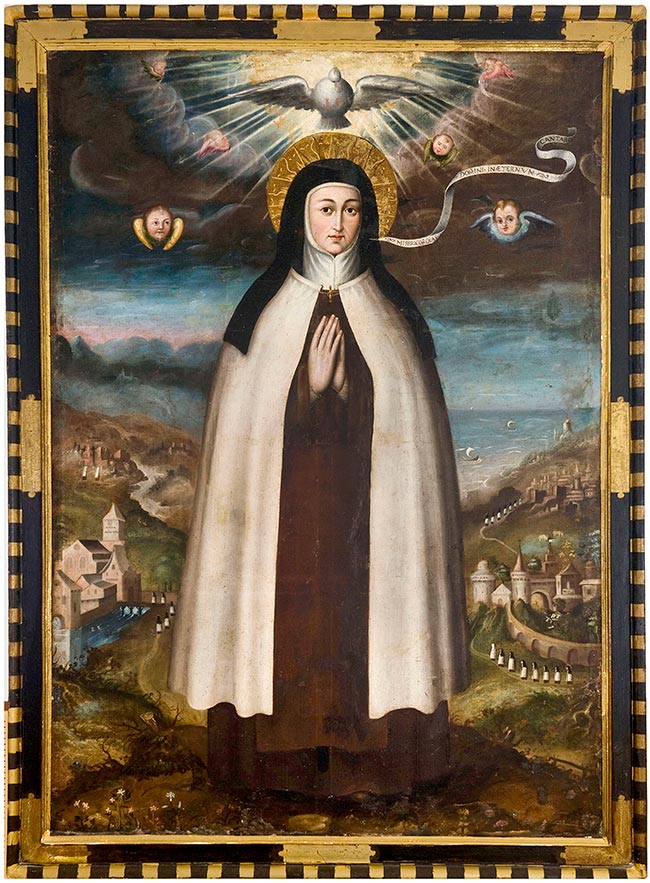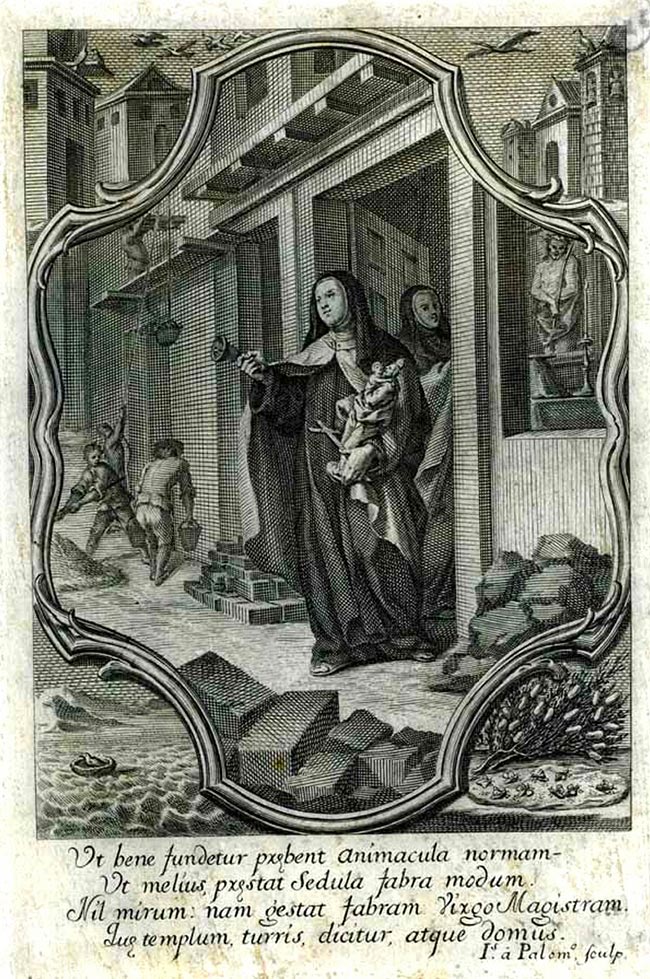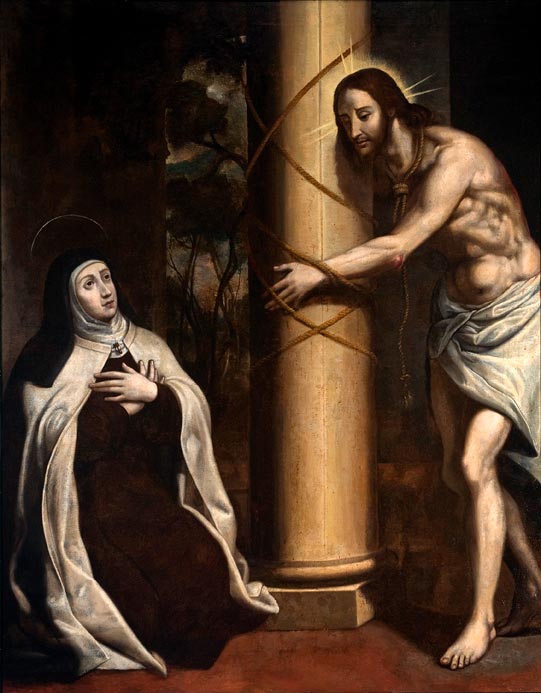Saint Teresa and images
"It is a great gift to see an image of the one we love for so many reasons".

PhotoCanvasof the saintly foundress of the Carmelites of San José de Pamplona, XVII. Photo J. L. Larrión/
Three major aspects stand out in Saint Teresa's relationship with the arts. Firstly, her attitude to images, her opinion of them, as well as the commissioning of others that she acquired or provided for her foundations. Secondly, all her iconography, exceptional in its abundance and typology, which constitutes a chapter A among the representations of the saints in the 17th century. Finally, we must consider that the foundations of the Discalced and Discalced Carmelite nuns preserved unique ensembles of architecture, sculpture, painting and sumptuary arts, together with a singular intangible heritage, which has survived over the centuries, particularly in the female cloisters. On this occasion we will deal with the former.
The saint's attitude to images, in the century of Humanism in which they were attacked and discussed, is not only in the Spanish tradition, but even introduces them into passages of her life and her mystical experiences. The visions before Christ at the Column, Saint Joseph and the Infant Jesus are a good example of this. For example, in recounting the death of her mother, she says: "when I began to understand what I had lost, I went to an image of Our Lady and begged her to be my mother..." (Life, 1,7). (Life, 1,7).
|
Canvas of the saintly foundress in the Carmelites of San José de Pamplona, 17th century. Photo J. L. Larrión |
Engraving of Saint Teresa the Foundress by Juan Bernabé Palomino in 1752, illustrating the works of the saint published in Madrid in that year by the Mercurio Printing House. |
In the saint's time, images were extraordinarily effective due to their scarcity, when there was plenty of time to contemplate them, so that those who looked at them could extract different sensations and evaluations. At final and as David Freedberg has masterfully written, comparing the past with the present, we no longer have "enough leisure to contemplate the images before our eyes, but once people did look at them; and they made contemplation useful, therapeutic, uplifting, comforting and fear-inspiring. All in order to achieve a state of empathy.
|
Vision of Saint Teresa before Christ at the Column, by Fray Diego de Leyva in the Discalced Carmelites of Pamplona, c. 1627. Photo J. L. Larrión |
Stamp of the Infant Jesus preserved in a reliquary of the Discalced Carmelite nuns of Santa Ana de Tarazona, which belonged to Saint Teresa of Jesus. Photo José Latova |
To the issue of images that the saint was able to contemplate in the temples and on her travels, we must add the holy cards she possessed: one with the Child Jesus sleeping on the heart, in allusion to the biblical phrase "Ego dormio et cor meum vigilat". Also the illustrations of the Breviary, published in Venice in 1568 and kept in the Carmelite monastery of Medina del Campo. In the Way of Perfection, reflecting on Christ in the Eucharist, he considers it foolish to look at his drawing, but admits his image, in some circumstances, with the following consideration: "Do you know for when it is very good and something in which I take great delight? Father Jerónimo Gracián, in his Escolias a la biografía de la santa, a work by the Jesuit Francisco de Ribera, writes: "Mother Teresa of Jesus was very devoted to well-painted images, and according to the Second Nicene Council, they are a great help in guiding souls to God. And although it is true that the image of Jesus Christ was often represented in her imagination as risen, with a crown of thorns and wounds and a white cloak, I know that she had more faith with any painted image. We know of some images of discreet quality that he acquired, personally and in small quantities, for his foundations. For example, for the Carmel of Toledo, she herself describes the passage as follows: "I left very happy, because it seemed to me that I already had everything, without having anything; because I must have had three or four ducats, with which I bought two canvases (because I had no image to put on the altar) and two pallets and a blanket" (Foundations, 15,6). And we also know of his concern to send devout images to some of his dovecotes, such as the sculpture of the Virgin for Caravaca, according to the testimony of a letter in which he writes: "Now I have to send to Caravaca an image of Our Lady that I have for them, very good and large, not dressed, and a Saint Joseph they are making for me, and it will not cost them anything".
To find out more
ÁLVAREZ, T. (dir.), Diccionario de Santa Teresa de Jesús, Burgos, Monte Carmelo, 2001.
FERNÁNDEZ GRACIA, R.,Estampa, Contrarreforma y Carmelo Teresiano. La colección de grabados de las Carmelitas Descalzas de Pamplona y Leonor de la Misericordia (Ayanz y Beaumont), Pamplona, I. G. Castuera, 2004.
FREEDBERG, D., El poder de las imágenes. programs of study sobre la historia y la teoría de la respuesta, Madrid, Chair, 1992.
GUTIÉRREZ RUEDA, L., "essay de iconografía teresiana", Revista de Espiritualidad (1964), pp. 1-168.
JERÓNIMO GRACIÁN DE LA MADRE DE DIOS, Escolias a la Vida de Santa Teresa compuesta por el P. Ribera, edited by J. L. ASTIGARRAGA, Roma, high school Histórico Teresiano, 1982.
MORENO CUADRO, F., Iconografía de santa Teresa, I, II y III, Burgos, Monte Carmelo, 2016 and 2017.




